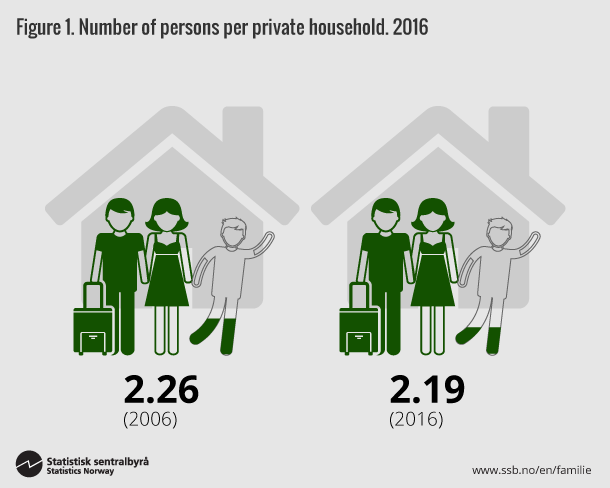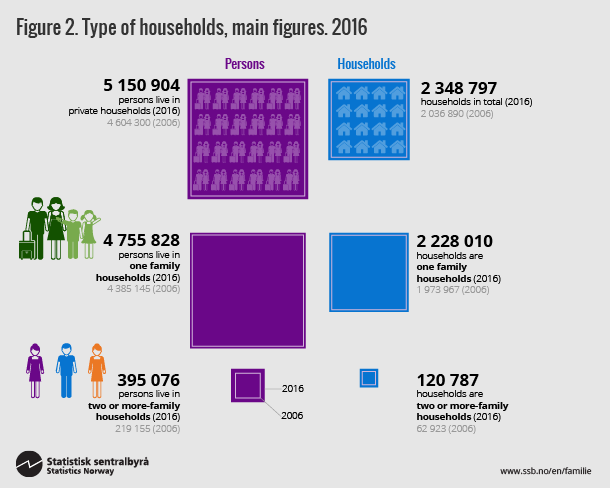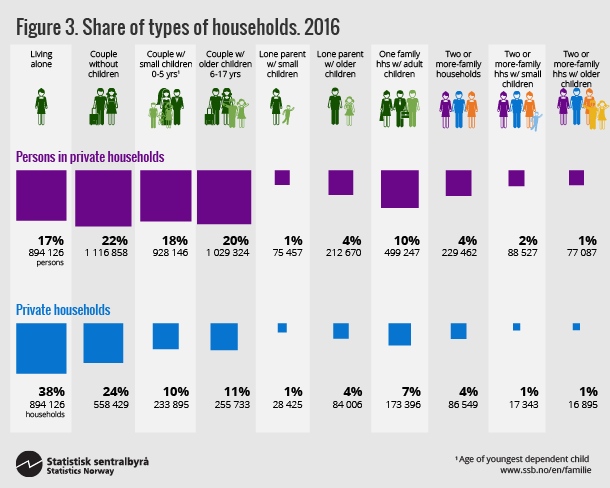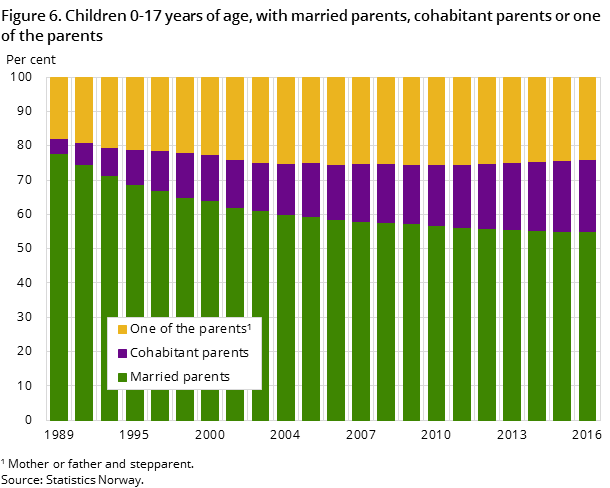Content
Published:
This is an archived release.
Share of households with children is falling
The share of households with children is slowly falling. On 1 January 2016, there were children in 27 per cent of a total of 2 348 800 private households in Norway. Twenty-five years ago, 32 per cent of the households had children.
| 2015 | 2016 | |
|---|---|---|
| Private households | 2 316 647 | 2 348 797 |
| Living alone | 877 983 | 894 126 |
| Couples without children | 547 295 | 558 429 |
| Married couples with children 0-17 years | 324 623 | 323 573 |
| Cohabiting couples with children 0-17 years | 162 461 | 166 055 |
| Mother/father with children 0-17 years | 114 171 | 112 431 |
| One_family households with adult children | 169 452 | 173 396 |
| Two or more-family households without children 0-17 years | 85 901 | 86 549 |
| Two or more-family households with children 0-17 years | 34 761 | 34 238 |
| Persons in private households | 5 096 732 | 5 150 904 |
| Number of persons per private househol | 2.20 | 2.19 |
| Population by type of households | 5 151 120 | 5 199 535 |
| Private households | 5 096 732 | 5 150 904 |
| One family households | 4 699 766 | 4 755 828 |
| Two or more-family households | 396 966 | 395 076 |
| Other housesholds | 54 388 | 48 631 |
It is the proportion of households with married couples with children 0-17 years that has dropped in this period. The percentage of cohabiting couples with children has increased slightly, while the proportion of single parents with children has remained unchanged. This development must be seen in light of the increase in the proportion of people living alone, from 34 to 38 per cent over the same period.
Fewer children live with siblings
As of 1 January 2016, a total of 1 111 800 children aged 0-17 years lived in Norway. The average number of children per family has dropped from 1.81 at the time of the Population and Housing Census in 2001 to 1.74 today. Twenty per cent of children live without siblings today. Fourteen years ago, this share was 17 per cent. In the same period, the proportion living with two or more siblings has declined somewhat, while the share living with only one sibling has increased. It is most common for children to live with one sibling only. In 2016, 46 per cent of all children live with one sibling, 25 per cent live with two siblings and 8 per cent live with three or more siblings.
Among the children who now live with siblings, 85 per cent live with full siblings only, while 8 per cent live with half siblings only. The remaining 7 per cent live with different combinations of full, half and step-siblings. These proportions have hardly changed since 2001.
20 per cent live with their mother
The proportion of children who live with one of their biological parents or adoptive parents only, has increased. Today 24 per cent of children live with their mother or father only, while the corresponding figure was 18 per cent in 1989. Among those who live with both parents, the proportion living with married parents dropped dramatically during this period, from 78 per cent in 1989 to 55 per cent today. The percentage of children living with both of their cohabiting parents increased in the same period from 5 to 21 per cent. In total, 76 per cent of children aged 0-17 years live with both parents today.
Among children living with one parent, it is far more common to live with their mother than with their father. Twenty per cent of the children live with a single mother and 4 per cent with a single father. Over the past ten years there has been an increase in the proportion of children living with a single father and a decrease in the proportion living with a single mother. Among children who live only with their mother or father, there will be a certain share who live with two adults at home, because they live with a step mother or step father.
The percentage of children living with one parent only is greatest in the three northernmost counties, where roughly three out of ten children live with one parent. The highest percentage of children living with married parents is in the counties of Vest-Agder and Rogaland, with 64 per cent. Trøndelag and Nordland are the counties where most children, 27 per cent, live with cohabiting parents.
Which of the parents the children live with varies with the age of the children. In the first living year, 88 per cent of the children live with their married or cohabiting parents, while this percentage gradually decreases to 62 per cent for 17 year-olds. In the first year, the percentages living with married and cohabiting parents respectively is equal, at 44 per cent. Among 17 year-olds, the percentage of children living with married parents increases to 53 per cent, while the proportion living with cohabiting parents gradually falls to 8 per cent.
32 150 more households in 2015
As of 1 January 2016, there were 2 348 800 private households in Norway. This is an increase of 32 150 households from 2015. The growing number of people living alone and the large increase in the number of people living in Norway both contribute to this development. An average of 2.19 persons now live in each household. It is most common to live in a household with two people; this applies to 28 per cent of the residents in private households, while 17 per cent live alone.
Contact
-
Statistics Norway's Information Centre
E-mail: informasjon@ssb.no
tel.: (+47) 21 09 46 42
-
Espen Andersen
E-mail: espen.andersen@ssb.no
tel.: (+47) 92 61 00 46
-
Ane Margrete Tømmerås
E-mail: ane.tommeras@ssb.no
tel.: (+47) 91 99 29 62
-
Oppdrag befolkningsstatistikk
E-mail: befolkning@ssb.no






